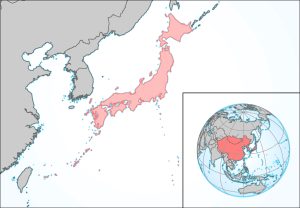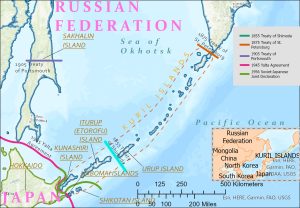58 East Asia: Political Geography I – Japan and the Kuril Islands

Photo by NASA Goddard Space Flight Center on Flickr.
The Kuril Islands are a string of 56 islands, stretching from Japan’s Hokkaido Island to Russia’s Kamchatka Peninsula. While these islands are part of Russia’s territory, some of the islands are claimed by Japan. Only thirteen of the islands are inhabited, though five islands have fewer than thirty people apiece. The islands are part of the Pacific Ring of Fire. As such, there are about 100 volcanoes on these islands, forty being active.
The original natives of the Kuril Islands are the Ainu people, whose reference to the islands derived from their word kur meaning man. The Ainu also lived on Sakhalin, now a Russian island, and on Hokkaido.

In the 17th century both Japanese and Russian explorers ventured to the islands, as even did the Dutch. Though not intense, interest in the islands continued, so that eventually some delineation of rights or ownership became useful. In 1855, Russia and Japan signed a treaty establishing their respective claims to the islands. The treaty designated that Japan held Iturup Island and all islands there southward, while Russia gained sovereignty over Urup Islands and islands northward. Nearby the large island Sakhalin would maintain Japanese, Ainu, and Russian populations. However, two decades later, interests had changed, so that the Treaty of St. Petersburg assigned all of the Kuril Islands to Japan, but all of Sakhalin Island to Russia. Russia’s abject failure in the 1904-1905 war with Japan resulted in loss of the southern half of Sakhalin.
Thus, going into World War II, Japan’s territory included all of the Kuril Islands, plus half of Sakhalin. In preceding years, the Russia Empire had been transformed into the Soviet Union (USSR). Nazi Germany had attacked and invaded the Soviet Union. Japan was Germany’s ally; however, for part of the war, the Soviet Union maintained a neutrality pact with Japan. Nevertheless, in April 1945 the Soviets legally renounced this pact, thereby allowing subsequent military action against Japan at the end of the war. As set by the Yalta Agreement between the USA, Britain, and the USSR, Soviet forces invaded the Kuril Islands in August 1945. In doing so, they fulfilled the Yalta pact that assigned the USSR all of the Kuril Islands as well as all of Sakhalin Island.

The 1951 Treaty of San Francisco was intended to close the door on World War II for Japan and all the allied countries; however, the USSR did not ratify the treaty, largely due to controversy over which of the Kuril Islands the Soviet Union would keep. Japan contended that the Habomia Islands and the islands of Shikotan, Kunashiri, and Etorofu were not technically in the Kuril chain, but actually belonged to the expanded physical landscape of the large Hokkaido Island. The Soviet Union rejected this assertion, arguing that the Kuril Islands included all islands north of Hokkaido and furthermore that the Yalta pact guaranteed these islands to the USSR. Now embroiled in the early years of the Cold War, the United States was reluctant to favor the Soviet position on this dispute.
In 1956, the Soviet Union and Japan signed the Soviet-Japanese Joint Declaration in order to end the state of war between the two countries, although literal warfare had ended in 1945. This declaration included the concession from the Soviet Union to return Shikotan and the Habomai Islands to Japan as soon as a peace treaty between the USSR and Japan was concluded. Curiously, this promise has never been fulfilled, for the two countries even by now in 2022 have never completed a peace treaty.
With the dissolution of the Soviet Union, Russia became its successor state and inherited all of the Soviet Union’s Russian Republic’s territory, including the Kuril Islands. In 2006, Russian president Vladmir Putin offered to cede Shikotan and the Habomai Islands to Japan, if Japan would renounce its claims to any other of the Kuril Islands. Japan rejected this offer, asserting that Kunashiri and Etorofu are not within the Kuril Islands. Japan doesn’t seek all of the Kuril Islands, but does want all of these few nearest islands, calling them the Northern Territories.

Given the intractability of this dispute, Russia has endeavored to develop these islands economically and even militarily. There is no doubt that possession of all of the Kuril Islands offers a naval benefit to Russian forces. The Kuril Island effectively seal the eastern edge of the Sea of Okhotsk, in effect turning the sea into a Russian waterway. Japanese rights to the sea extend only briefly from the northern coast of Hokkaido before intersecting with Russian waters. The string of the Kuril Islands allows Russian naval vessels to pass freely and smoothly between the Sea of Okhotsk and the open waters of the Pacific Ocean. Additionally, the exclusive economic zone of the Kuril Islands extends 200 miles eastward. Russia has increased its military presence on the islands, even running military drills.
While the Kuril Islands have little economic value, they have an exaggerated military value for their meager area and small population. Russia feels generous in offering Japan two of these islands, but senses no urgency in doing anything about the issue. While Russia otherwise seems interested in adding territory (Ukraine), perhaps this offer should be accepted. Occasional negotiations occur, but with no resolution of the issue. Japan is politically invested in the dispute, but has no leverage to push Russia to accept the Japanese position.
Did you know?
When Russians arrived at the Kuril Islands, the toponym (place name) had a different sense for them. The Russian word курить means “to smoke,” thereby the volcanic smoke and steam matched the name.
Although the Russian Far East has appeal for tourist and the Kuril Islands feature bird populations to delight “birders,” tourism in the Kuril Islands is almost zero.
Cited and additional bibliography:
Arendt, Jonathan. Japan and the Kuril Islands. College of DuPage GIS class. July 2022.
Mikovic, Nikola. “Why Russia Will Not Return the Kuril Islands to Japan.” the interpreter, November 17, 2020. https://www.lowyinstitute.org/the-interpreter/why-russia-will-not-return-kuril-islands-japan.
NASA Goddard Space Flight Center. “Tao-Rusyr Caldera, Onekotan Island, Kuril Islands,” March 30, 2017. Attribution 2.0 Generic. https://www.flickr.com/photos/gsfc/33582832762/.
Peter. Iturup Island. August 12, 2013. Attribution 2.0 Generic (CC BY 2.0) https://www.flickr.com/photos/acidka/16116034608/.
Wiertz, Steve. Japan. College of DuPage GIS class, May 2022.
Wiesinger, Elsa. “Increasing Tensions In Russia-Japan Kuril Islands Dispute.” The Organization for World Peace, August 18, 2021. https://theowp.org/increasing-tensions-in-russia-japan-kuril-islands-dispute/.

